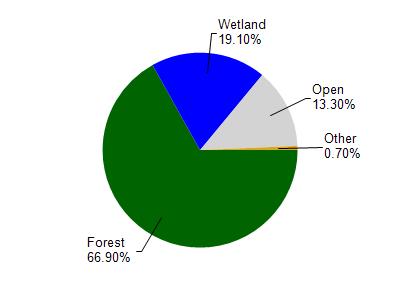Iron, Vilas
No
No
No
Fish and Aquatic Life
Overview
Circle Lily Lake, in the Manitowish River Watershed, is a 218.12 acre lake that falls in Iron and Vilas Counties. This lake is managed for fishing and swimming and is currently not considered impaired.
Date 2011
Author Aquatic Biologist
Historical Description
Source: 1963, Surface Water Resources of Vilas County Circle Lily Lake, T-42-N, R-5-E, Sections 5 and 61
Circle Lily Lake is a moderately-fertile drainage lake. It has slightly acid to slightly alkaline, medium brown water of low transparency. Bottom materials in this lake are quite variedhowever, sand and gravel predominate. The inlet of the lake is small, but the outlet is considered a navigable stream. The lakeis managed as a walleye-muskellunge lake; however, largemouth bass are also common and the pan fish fishery is excellent. Suckers and red horse are abundant. The lake has good public use possibilities as access is available by town road with parking as well as by navigable water and unimproved or difficult access. There is one resort on the lake. Only six dwellings are scattered about the shore leaving a wild quality to the shores.
Area = 223 Surface Acres, Maximum Depth = 35 feet
Date 1963
Author Surface Water Inventory Of Wisconsin
Impaired Waters
Circle Lily Lake (WBIC 2326700) was placed on the impaired waters list for excess algal growth in 2016. The 2018 assessments showed continued excess algal growth; new chlorophyll-a sample data exceeded the 2018 WisCALM listing thresholds for the Recreation use. Total phosphorus sample data were clearly below the Recreation use and Fish and Aquatic Life use listing thresholds. Based on the most updated information, no change in the existing impaired waters listing was needed.
Date 2017
Author Ashley Beranek
Impaired Waters
Circle Lily Lake (WBIC 2326700) was assessed during the 2016 listing cycle; chlorophyll sample data exceed 2016 WisCALM listing thresholds for the Recreation use, however, total phosphorus data do not exceed REC thresholds. Total phosphorus and chlorophyll data do not exceed Fish and Aquatic Life thresholds.
Date 2015
Author Aaron Larson
Condition
Wisconsin has over 84,000 miles of streams, 15,000 lakes and milllions of acres of wetlands. Assessing the condition of this vast amount of water is challenging. The state's water monitoring program uses a media-based, cross-program approach to analyze water condition. An updated monitoring strategy (2015-2020) is now available. Compliance with Clean Water Act fishable, swimmable standards are located in the Executive Summary of Water Condition in 2018. See also the 'monitoring and projects' tab.
Reports
Recommendations
Master Planning
This project will complete a Smart Growth compliant plan for the Township of Manitowish Waters. Specifically, this grant will cover portions of the agricultural/natural resources/cultural, internal governmental, land use, and implementation strategy elements.
Management Goals
Wisconsin's Water Quality Standards provide qualitative and quantitative goals for waters that are protective of Fishable, Swimmable conditions [Learn more]. Waters that do not meet water quality standards are considered impaired and restoration actions are planned and carried out until the water is once again fishable and swimmable
Management goals can include creation or implementation of a Total Maximum Daily Load analysis, a Nine Key Element Plan, or other restoration work, education and outreach and more. If specific recommendations exist for this water, they will be displayed below online.
Monitoring
Monitoring the condition of a river, stream, or lake includes gathering physical, chemical, biological, and habitat data. Comprehensive studies often gather all these parameters in great detail, while lighter assessment events will involve sampling physical, chemical and biological data such as macroinvertebrates. Aquatic macroinvertebrates and fish communities integrate watershed or catchment condition, providing great insight into overall ecosystem health. Chemical and habitat parameters tell researchers more about human induced problems including contaminated runoff, point source dischargers, or habitat issues that foster or limit the potential of aquatic communities to thrive in a given area. Wisconsin's Water Monitoring Strategy was recenty updated.
Grants and Management Projects
Monitoring Projects
| WBIC | Official Waterbody Name | Station ID | Station Name | Earliest Fieldwork Date | Latest Fieldwork Date | View Station | View Data |
|---|
| 2326700 | Circle Lily Lake | 10019909 | Circle Lily Lake -- Ramp | 5/26/2006 | 6/15/2021 | Map | Data |
| 2326700 | Circle Lily Lake | 643459 | Circle Lily Lake - Deep Hole | 7/21/1996 | 6/30/2024 | Map | Data |
| 2326700 | Circle Lily Lake | 10006398 | Circle Lily Lake | 5/3/1994 | 9/8/2023 | Map | Data |
|

Watershed Characteristics
Circle Lily Lake is located in the Manitowish River watershed which is 268.60 mi². Land use in the watershed is primarily forest (66.90%), wetland (19.10%) and a mix of open (13.30%) and other uses (0.70%). This watershed has 212.08 stream miles, 22,943.16 lake acres and 33,727.48 wetland acres.
Nonpoint Source Characteristics
This watershed is ranked Low for runoff impacts on streams, Low for runoff impacts on lakes and Low for runoff impacts on groundwater and therefore has an overall rank of Low. This value can be used in ranking the watershed or individual waterbodies for grant funding under state and county programs.However, all waters are affected by diffuse pollutant sources regardless of initial water quality. Applications for specific runoff projects under state or county grant programs may be pursued. For more information, go to surface water program grants.